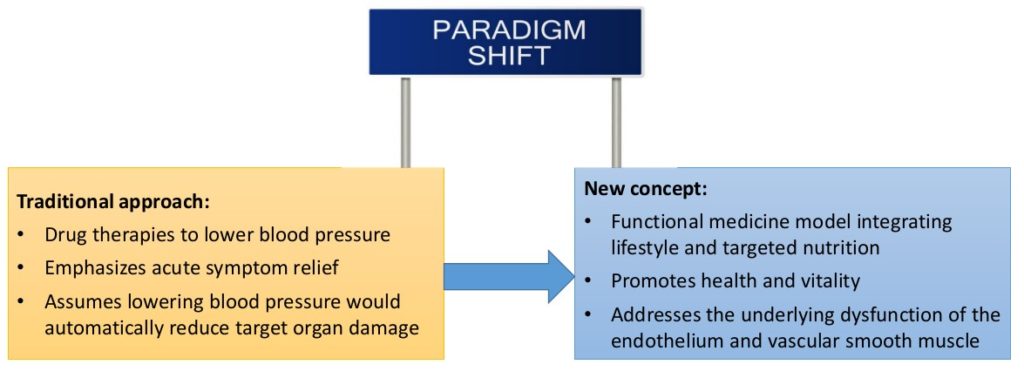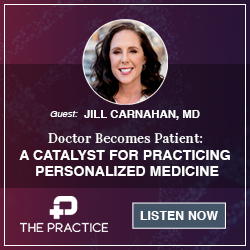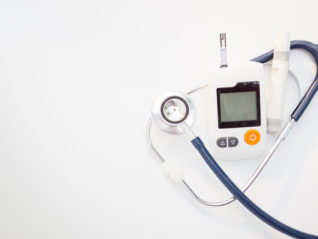
by Mark Houston, MD and Sara Gottfried, MD
| Abstract. Hypertension is the most common and modifiable risk factor for cardiovascular disease. Rather than a disease, hypertension is a manifestation of an abnormal vascular system. Therein is both the problem and opportunity: we need a systems biology approach to address the root cause of hypertension and reduce our patient’s risk of cardiovascular disease. In 2017, new guidelines lowered the criteria for the diagnosis of hypertension from 140/90 to 130/80. As more patients now meet criteria for hypertension, we urgently need evidence-based diet, lifestyle, and nutraceutical recommendations to limit our patient’s risk of downstream consequences, including stroke, heart attack, and dementia. |
We all know the drill. Go to the doctor’s office, get your blood pressure taken. Sit up straight, feet on floor, cuff properly fitted one inch above the antecubital fossa, arm flexed with flexed elbow at the level of the heart. Cuff squeezes arm, then a whoosh of relief—or at least until two years ago.
In 2017, the American Heart Association and American College of Cardiology substantially lowered the threshold for a hypertension diagnosis: 130/80 instead of 140/90, which pushed about half of US adults and 80% of seniors into the diagnosis of hypertension. As practitioners and thought leaders debate the merit of the stricter standards, more patients require our best therapeutic diet, lifestyle, and nutraceutical recommendations to limit their risk of downstream consequences, including stroke, heart attack, and dementia. Hypertension is not a disease but rather a manifestation of an abnormal vascular system. Therein is both the problem and opportunity: we need a systems biology approach to address hypertension and reduce our patient’s risk.
Up the Pressure: New Guidelines on Diagnosis and Treatment of Hypertension
Up until 2016, the CDC estimated that 1 in 3 adults have high blood pressure,1 and only about half (54%) have their blood pressure under control. Now with new guidelines, the gap looms larger. While we all know that hypertension is an important modifiable risk factor for cardiovascular morbidity and mortality, increasingly young people are being diagnosed with high blood pressure which has long-term negative health effects.2 For many, hypertension pharmaceuticals can effectively lower blood pressure, but some types may cause side effects such as muscle cramps, weakness, constipation, diarrhea, and erectile dysfunction.
As a result, millions of Americans have been turning to functional medicine practitioners to promote health and vitality by integrating conventional practices with prevention through combinations of drugs and/or botanical medicines, supplements, therapeutic diets, detoxification, exercise, and stress management rather than emphasizing acute symptom relief, urgent care, and elimination of illness and disease.3 Functional medicine looks for interactions between genetic, environmental, and lifestyle factors. Going beyond treating a number on a sphygmomanometer or wearable, precision medicine examines the underlying physiology of hypertension, looking at the arterial structure and function in very different ways.
Reframing the Concept of Hypertension
When you view hypertension as a manifestation of an abnormal vascular system, you quickly realize that the relationship between the injured endothelium, vascular smooth muscle, and three finite responses of the arteries result in the hemodynamic marker of high blood pressure and produce the symptoms of hypertension. The three responses of the arterial system are inflammation, oxidative stress, and autoimmune dysfunction.
No matter the incoming insult—chemicals, toxins, pesticides, blood sugar, lipids, or microbial—the artery can only respond in those three ways. Inside the arterial wall are pattern recognition receptors. They have names like toll-like receptor (TLR), NOD-like receptor (NLR), and caveolae, and these receptors look at what’s coming in and decide whether it’s a friend or a foe.4 If the receptors decide that the insult is friendly, then the response will be normal and the patient’s blood pressure won’t go up.4
But if that insult happens to be a foreign compound, the arterial wall senses that and says, “I have to respond to this in an acute setting.” If the arterial wall continues to be insulted, it becomes a chronic dysregulated response. The receptors stimulate signal transduction to the rest of the arterial system, and it sets off the three finite responses, which then translate into what we call hypertension. Hypertension is the marker for a diseased artery. One of the big insults and mediators of hypertension is a lack of nitric oxide bioavailability. If the nitric oxide levels are low, there will be vasoconstriction. The arteries respond by narrowing, decreasing blood flow, and also respond with inflammation, oxidative stress, and immune dysfunction.
Paradigm Shift
Therefore, the evolving concept is that hypertension is an inflammatory problem, an oxidative stress problem, and an autoimmune problem. If you think about those three interwoven conditions, it makes it much easier to address therapeutic modalities to reverse hypertension. This is a total change in the traditional paradigm and approach to hypertension. In the past, a successful therapeutic program for hypertension was to lower the blood pressure. The assumption was if you lower the blood pressure, you’ve automatically reduced target organ damage from cardiovascular disease—strokes, coronary heart disease, myocardial infarctions, congestive heart failure, renal disease or diseases of the large arteries like aortic aneurysms. The problem we’ve recognized over the years is that our pharmacologic therapies can change the blood pressure to normal levels, but the arterial structure and function do not change back to normal.
In 1995, Dr. Ernesto Schiffrin in Montreal conducted a clinical study examining change in arterial structure and function in two intervention groups.5 The first group was given a typical regimen of a diuretic or a beta-blocker. In group two, Schiffrin put patients on a different regimen which consisted of an ACE-inhibitor, an angiotensin-receptor blocker or a calcium-channel blocker. All participants had the same nutrition and supplements; and weight, or other confounding variables were controlled between groups. At the end of the year, researchers found that despite the fact that the blood pressure was the same in both groups, there was a huge difference in the outcomes of the structure and function of the arterial system.5 In other words, the structure and function of the native artery in the hypertensive patient who was placed on a diuretic or beta-blocker did not change. Their status remained abnormal related to contractility and thickness of the arterial wall, despite the fact that the blood pressure was identical to the ones who got the other drugs like angiotensin-receptor blockers, ACE-inhibitors, and calcium-channel blockers. This was the first study to show that it’s not just getting the blood pressure down that is important, but what’s more important is how you get the blood pressure down.5
Precision and Personalized Medicine Model
This takes us into the whole new concept of how nutrition and nutraceuticals can be used in a Precision and Personalized Medicine model to achieve healthy vascular biology. Our new goal is to improve the structure and function of the arterial wall by addressing both endothelial dysfunction and vascular smooth muscle. Both of those have to be improved in order for the outcomes to manifest with a reduction in cardiovascular target organ damage.
At the Hypertension Institute, we conducted several studies looking at how we could devise a program that’s nutrition- and supplement-based to achieve the new goals.6-8 For example, we investigated in a randomized double-blind placebo-controlled trial whether a particular nutritional program and lifestyle change would result in the ultimate changes in vascular biology that translate into lower blood pressures and also into arterial health. The study measured endothelial function, arterial compliance, arterial structure, and surrogate markers.9 Results found that nutritional programs, like the Mediterranean diet, the DASH-II diet, specific nutraceutical combinations, or one specific nutrient given in high doses can simulate the actions of an antihypertensive drug. Doing so allows the practitioner who has been heretofore pharmacologically-based, to now incorporate a nutrition program or a supplement program to simulate the class of drugs that has been shown to affect arterial structure and function and also reduce blood pressure.
The classic reduction in blood pressure with one drug is approximately 10 over 5 millimeters in blood pressure reduction. With two equivalent drugs, the DASH-II diet and specific combinations of nutraceuticals, a patient could achieve as much as a 20 over 10 reduction in blood pressure. To test our hypothesis that it is possible to get a lot of people off all hypertensive drugs, we evaluated micronutrient deficiencies and oxidation status, in a group of almost 700 hypertensive patients.10 Macronutrients and micronutrients that may be crucial in the regulation of blood pressure are often deficient in hypertensive patients due to genetics, environment, and prescription drugs. We observed that replacement of the micronutrient deficiencies, as well as high-dose therapy of selected nutraceuticals in combination with optimal diet, exercise and weight management resulted in control of blood pressure to goal levels in 62% of the hypertensive population (as defined by JNC 7) over a period of 6 months with complete tapering and discontinuation of antihypertensive medications.10 Successful repletion of micronutrient deficiencies had a major contribution to clinical success.
Testing and Treatment Goals
Standard blood pressure measurements using an office cuff often do not accurately reflect cardiovascular health and can be misleading. The new gold standard is an ambulatory blood pressure monitor (24 ABM). One office cuff reading does not determine risk, nor does it determine the correct therapy. The ability to noninvasively measure blood pressure in central arteries is an important advancement because the central and brachial pressure do not always correlate. The 24 ABM measures risk of a load of blood pressures over 24 hours, including nocturnal blood pressure, dipping status, white coat and masked hypertension, circadian rhythms with the early morning surges known to be associated with cardiovascular events and strokes, load (the percentage of reading greater than 140/90 mm Hg), and blood pressure highs, lows, and variability. Nocturnal blood pressure predicts event risk much better than daytime pressures.11
However, the treatment goals in hypertension management must go beyond only measuring blood pressure. If you use that as your only criteria for success, then you’ve really missed the boat on reducing target organ damage. New parameters include the ability to measure the arterial function with noninvasive equipment. For example, the EndoPAT measures endothelial dysfunction.12 That’s a valuable test to determine if therapy is achieving optimal function of the arterial wall. In addition, computerized arterial pulse wave analysis measures the structure of the arterial wall.12 With those two tests, supporting biomarkers and other tests, practitioners can observe lowered the blood pressure with a 24 ABM, changed arterial function and structure, and therefore, a decrease in cardiovascular risk.
Conclusions
While there is a role of genetic predisposition, 80% of vascular disease is environmental. The key to prevention and treatment of hypertension and cardiovascular disease, then, is in modulation of the environmental insults and the downstream disturbances of gene expression patterns. An integrative approach combining lifestyle suggestions and correcting possible nutrient deficiencies with the correct pharmacologic treatment will best achieve new goals for blood pressure levels, reduce cardiovascular risk factors, improve vascular biology and vascular health, reduce cardiovascular TOD, and reduce health care expenditures.
Citations
- Merai R et al. CDC Grand Rounds: A Public Health Approach to Detect and Control Hypertension. MMWR Morb Mortal Wkly Rep. 2016;65:1261-1264.
- Jackson SL et al. Hypertension Among Youths – United States, 2001-2016. MMWR Morb Mortal Wkly Rep. 2018;67:758-762.
- Houston MC. The role of nutrition, nutraceuticals, vitamins, antioxidants, and minerals in the prevention and treatment of hypertension. Altern Ther Health Med. 2013;19 Suppl 1:32-49.
- Houston M et al. Recent Science and Clinical Application of Nutrition to Coronary Heart Disease. J Am Coll Nutr. 2018;37:169-187.
- Schiffrin EL et al. Progressive improvement in the structure of resistance arteries of hypertensive patients after 2 years of treatment with an angiotensin i-converting enzyme inhibitor*: Comparison with effects of a β-blocker. Am J Hypertens. 1995;8:229-236.
- Houston M. Nutrition and nutraceutical supplements for the treatment of hypertension: part III. J Clin Hypertens (Greenwich). 2013;15:931-937.
- Houston M. Nutrition and nutraceutical supplements for the treatment of hypertension: part II. J Clin Hypertens (Greenwich). 2013;15:845-851.
- Houston M. Nutrition and nutraceutical supplements for the treatment of hypertension: part I. J Clin Hypertens (Greenwich). 2013;15:752-757.
- Houston M et al. Acute effects of an oral nitric oxide supplement on blood pressure, endothelial function, and vascular compliance in hypertensive patients. J Clin Hypertens (Greenwich). 2014;16:524-529.
- Houston MC. The role of cellular micronutrient analysis, nutraceuticals, vitamins, antioxidants and minerals in the prevention and treatment of hypertension and cardiovascular disease. Ther Adv Cardiovasc Dis. 2010;4:165-183.
- Alexander W. Hypertension: is it time to replace drugs with nutrition and nutraceuticals? P T. 2014;39:291-295.
- Houston M. The role of noninvasive cardiovascular testing, applied clinical nutrition and nutritional supplements in the prevention and treatment of coronary heart disease. Ther Adv Cardiovasc Dis. 2018;12:85-108.
Mark Houston, MD, MS, FAHA, FASH, DABC is a highly recognized cardiovascular and hypertension specialist, serving as a physician at St. Thomas West Hospital in Nashville, where he holds several leadership positions including Director of the Hypertension Institute and Vascular Biology, Medical Director of Clinical Research, and Section Chief for the Division of Nutrition. Dr. Houston cofounded the Hypertension Institute, which is one of the leading institutes in the US for hypertension treatment. An American Society of Hypertension (ASH) specialist and Diplomate of the American Board of Cardiology, Dr. Houston is also a Fellow of the American Society of Hypertension (FASH), the American Heart Association (FAHA), Internal Medicine (ABIM), American College of Nutrition (FACN) and Anti-Aging Medicine (ABAARM). Dr. Houston received his medical degree from Vanderbilt University. He also obtained two master’s degrees, in Human Nutrition and Metabolic Medicine and Human Nutrition, from the University of Bridgeport and University of South Florida, respectively.
Sara Gottfried, MD is a board-certified gynecologist and physician scientist. She graduated from Harvard Medical School and the Massachusetts Institute of Technology and completed residency at the University of California at San Francisco. Over the past two decades, Dr. Gottfried has seen more than 25,000 patients and specializes in identifying the underlying cause of her patients’ conditions to achieve true and lasting health transformations, not just symptom management.
Dr. Gottfried is a global keynote speaker who practices evidence-based integrative, precision, and Functional Medicine. She recently published a new book, Brain Body Diet and has also authored three New York Times bestselling books: The Hormone Cure, The Hormone Reset Diet, and Younger.







